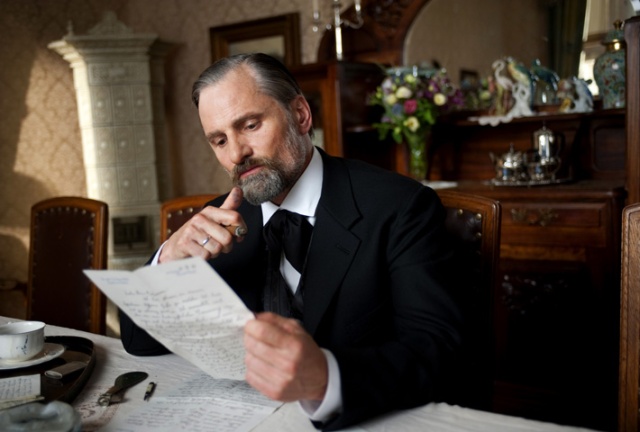Talking Cure, by David Bax
In many ways, A Dangerous Method, an adaptation of Christopher Hambert’s play The Talking Cure (itself an adaptation of John Kerr’s book A Most Dangerous Method), seems an odd fit for director David Cronenberg. Having first made his name as a director of grisly yet cerebral horror films, he continued his dark somatic fixation in later works such as Dead Ringers, Crash and A History of Violence. So it seems out of character for him to tackle a truth-based story of the famous pioneers of psychoanalysis, Carl Jung and Sigmund Freud. At the risk of spoiling the film for Cronenberg’s fans, it contains no mutilations of note. Yet, on closer inspection, it becomes clear that the filmmaker is perfectly suited to this material.
Given the film’s setting of pre-World War I Europe – a time when Victorian and Edwardian strict codes of conduct persisted – the director’s measured and controlled approach makes sense. Furthermore, Cronenberg’s “body horror,” in which corpus is rent, mutated and destroyed, was always about the psychological manifesting itself through the physical. Freud, Jung and their contemporaries sought to force that manifestation into a safe, therapeutic, verbal form. Though the expression is a change for Cronenberg, the source of the turmoil is the same.
Since it is so early in the history of psychoanalysis, though, the story begins with a decidedly physical articulation of mental distress. Keira Knightley plays Sabina Spielrein, a patient of Jung’s. When we are introduced to her, she is so wracked with inner anguish that she can’t even speak without her face and body distorting themselves with painful-looking tics and spasms. Cronenberg makes no attempt to garnish or otherwise decorate these scenes, displaying Knightley’s full, physical performance so matter-of-factly that you may want to turn away out of overwhelming sympathy. I remain yet to be sold on her range as an actor but this is without exception the performance of her career because she devotes herself to it with full abandon.
The other performances, of which there are only a few, are equally solid. Michael Fassbender, as he’s proven in every third movie to have been released in the last twelve months, is an actor of great skill. He plays Jung with a façade calm enough that the slightest change in expression belies a deep reservoir of insecurity and naivete, despite his formidable education. Viggo Mortensen, in his third consecutive collaboration with Cronenberg, remains a worthy match for the director’s needs, playing Freud simultaneously as the sympathetic underdog (he’s Jewish and of meager means compared to Jung’s aristocratic Protestant background) and as the egotistical boor, obviously threatened by Jung. Rounding out the cast are Sarah Gadon as Jung’s wife, Emma, and Vincent Cassel as Otto Gross, another therapist. Gadon’s moving but subtle performance is unfairly doomed to be overshadowed by her costars. The usually reliable Cassel, however, is done no favors by a screenplay that is interested in him only as a symbolic foil to Jung.
Knightley, Fassbender and Mortensen are clearly the three leads here but the story belongs largely to Jung, with occasional forays into Spielrein’s life. After treating her, Jung becomes her teacher and also her lover. While she grows into a successful therapist in her own right, Jung develops an equally respectful and combative collegial relationship with Freud.
Beyond that, there is little plot to speak of. Still, with Cronenberg’s usual mastery of pace, things zip along almost unnoticeably. Watching one of his films is almost like riding on a super-modern bullet train that runs so smoothly you almost don’t realize how quickly you’re moving. The director also displays an assured command of tone and atmosphere. Despite the characters promoting a “talking cure,” there is a surprising number of scenes in which what is said is not what is really going on. In each of these, whether they take place in an office, on a park bench or on the deck of a great steamship, Cronenberg discreetly but effectively conveys the mood of the frame’s inhabitants, making it clear what you should be taking away from the exchange.
Horror directors are often wrongfully overlooked in the discussion of great formalist and structuralist filmmakers. So it is sad, in a way, that Cronenberg, who has been assembling compositions and sequences worthy of being called high art since his earliest works, gets more respect from stuffy awards-granting organizations the further he strays from his native genre. Here, as always, he is rewardingly fetishistic in the assemblage and presentation of his shots.
In terms of narrative and momentum, A Dangerous Method never lifts off the way A History of Violence and Eastern Promises did. Despite that, it is yet another piece of evidence that David Cronenberg is one of the most skillful and powerful directors of film working today.































Im glad somebody else enjoyed this film as much as I did.